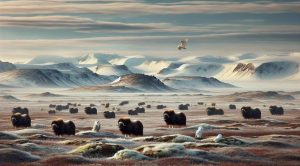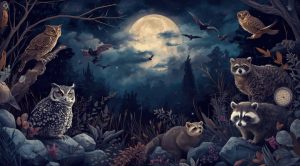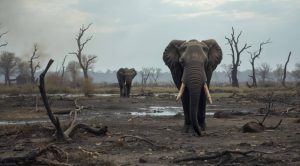Tundra Wildlife
What Is the Tundra
The tundra is one of the planet wide natural regions that captures the imagination of scientists and nature lovers alike. Characterized by low temperatures short growing seasons and a layer of permafrost below the surface the tundra supports a unique community of plants and animals that are adapted to these extreme conditions. There are two main types of tundra Arctic tundra near the polar circle and alpine tundra high on mountain ranges where cold conditions limit tree growth. Both types host an array of species that together define the world of tundra wildlife.
Why Tundra Wildlife Matters
Tundra wildlife plays a key role in global ecological processes. Many tundra animals are part of long distance migration cycles that connect the tundra to distant forests coasts and wetlands. Plants and microbes in tundra soils store and cycle nutrients and carbon in ways that influence global climate patterns. The presence and health of tundra wildlife is therefore an indicator of broader environmental changes. For readers who want to explore more about natural regions and living systems visit bionaturevista.com for in depth articles and field guides.
Adaptations That Define Tundra Wildlife
Survival in the tundra requires unusual adaptations. Many mammals and birds develop insulating coats or fat layers that reduce heat loss. Some species migrate to avoid the coldest months while others remain active below layers of snow that act as insulation. Reproductive strategies are tuned to short summers so that young are born during the period of greatest food abundance. Plants tend to grow close to the ground to avoid wind and to retain heat. Lichens mosses and hardy flowering plants form the backbone of tundra vegetation and provide food and habitat for herbivores.
Key Species of Tundra Wildlife
A look at characteristic tundra wildlife reveals a mix of large and small species each with a role in the ecosystem. Herbivores such as caribou and reindeer graze on mosses and shrubs and in doing so shape plant communities. Small mammals like lemmings provide a crucial food source for predators and their population cycles can drive changes in predator numbers. Predators include the Arctic fox the red fox in some regions and large birds of prey such as snowy owls that time nesting to peak prey abundance. Marine coastal tundra areas support seals seabird colonies and other species that link ocean productivity to terrestrial food webs.
Behavior and Migration Patterns
Migration is central to many examples of tundra wildlife. Birds such as geese and waders travel vast distances from wintering grounds to breed in the summer tundra where long daylight hours allow rapid growth of chicks. Large herbivores migrate between wintering and summering grounds to follow the best forage. These movements are finely tuned to seasonal cues and changes in ice cover and plant phenology. Climate related shifts in these cues can alter migration timing and create mismatches between breeding periods and food availability with cascading effects through the whole system.
The Role of Small Mammals
Small mammals like voles and lemmings have outsized influence in tundra systems. Their population numbers can vary dramatically from year to year and the abundance of these small mammals affects predators such as foxes hawks and owls. Burrowing activity modifies soil structure and nutrient availability which in turn feeds back into vegetation patterns. Studying these species offers insight into how energy moves through tundra food webs and how trophic interactions respond to environmental change.
Plants That Support Tundra Wildlife
Tundra vegetation may appear sparse but it is highly specialized. Cushion plants form low mats that trap heat and moisture. Sedges and grasses grow quickly during the brief summer providing key forage for herbivores. Lichens photosynthesize at low temperatures and can be a vital winter food source for reindeer. Shrubs such as dwarf willow grow in protected micro sites and offer shelter to birds and small mammals. The composition of plant communities controls habitat suitability for many animal species and shifts in plant distribution signal broader ecological responses to warming climates.
Threats to Tundra Wildlife
Tundra wildlife faces a growing list of threats. Rising temperatures are causing permafrost thaw and changes in seasonal timing that alter habitats. Shrub expansion can transform open tundra into shrubland with consequences for species that rely on low vegetation. Increased human activity including resource extraction and expanded transport corridors fragments habitat and brings new disturbances. Invasive species may establish more easily as conditions warm and the resulting competition can harm native populations. Conservation efforts must therefore consider both local actions and broader climate mitigation to protect tundra wildlife.
Conservation Strategies
Effective conservation of tundra wildlife blends protected area management monitoring and community involvement. Protected areas safeguard critical breeding and wintering sites but need to be large enough to allow migration routes. Long term monitoring programs track changes in species distribution and abundance and help identify emerging threats. Indigenous communities hold deep ecological knowledge and play an essential role in stewardship. Restoration projects can focus on stabilizing permafrost preventing erosion and maintaining natural hydrology to support native species. International cooperation is crucial because many tundra species cross political boundaries as they migrate.
How to Observe and Learn Responsibly
If you plan to observe tundra wildlife in person respect for the environment should guide every action. Stay on established trails keep distance from wildlife and follow local rules for camping and waste disposal. Seasonality matters so plan visits during times that minimize disturbance to breeding animals. For those who cannot travel there are excellent educational resources and visual media that bring tundra ecosystems to life. To find curated film and video content that highlights natural systems and species behavior consider trusted media guides such as Moviefil.com which can point you to films that illuminate the lives of tundra animals and the challenges they face.
The Future of Tundra Wildlife
The future of tundra wildlife will depend on our ability to limit climate impacts and to implement thoughtful conservation actions. Research that links species responses to changing physical conditions will improve predictions and inform policy. Community based approaches that combine traditional knowledge and scientific research offer realistic paths for adaptation and stewardship. By building broad public awareness and supporting targeted protections we can help ensure that the diverse array of species that define tundra wildlife will continue to thrive for generations to come.
Further Reading and Resources
Learning about tundra wildlife strengthens the motivation to protect these fragile systems. Field guides research articles and multimedia resources all contribute to a deeper understanding. For more nature articles guides and project ideas related to different ecosystems visit our main portal at bionaturevista.com where you will find in depth coverage that supports exploration and conservation of the natural world.















